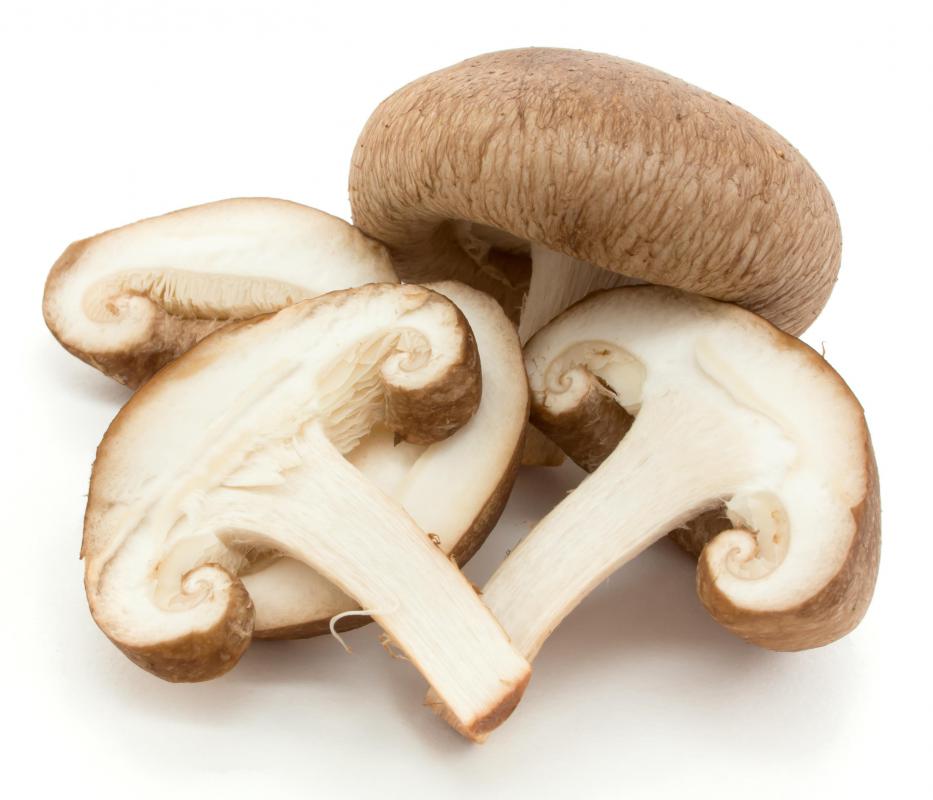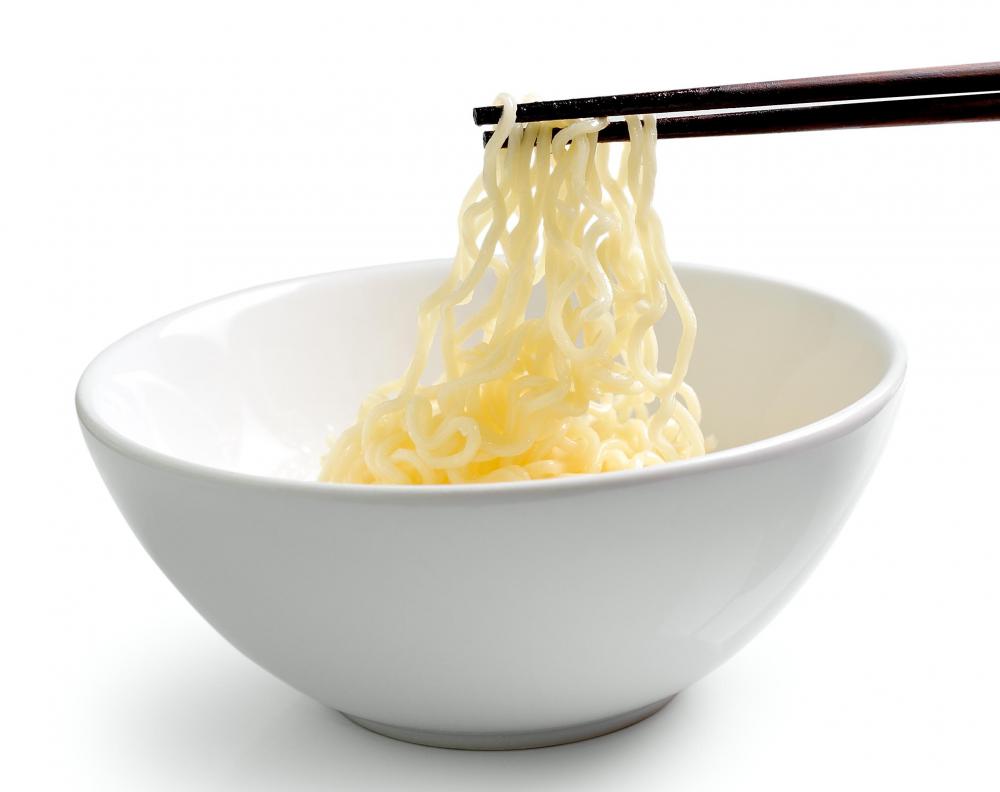At DelightedCooking, we're committed to delivering accurate, trustworthy information. Our expert-authored content is rigorously fact-checked and sourced from credible authorities. Discover how we uphold the highest standards in providing you with reliable knowledge.
What is Ramen?
Ramen is a Japanese noodle dish that consists of a meaty broth, noodles, and shredded vegetables and meats. The popular food is available fresh at noodle stands all over Japan, and also in a dried, packaged form that is widely eaten all over the world. Inexpensive packaged ramen is often associated with poverty, because it provides basic nutrition on a limited budget and can be easily dressed up with the addition of vegetables and meats. In Japan, this dish is eaten widely by all classes, and can be found in incarnations from simple to gourmet.
The tradition of noodles in Japanese cuisine is very old, although wheat noodles in broth probably date back to the 1700s. The addition of meats to the broth was largely a response to interaction with the West, where large amounts of meat products are eaten. The concept of noodles in broth became very popular with street side stands, and continues to be in Japan to this day, where most major cities have a plethora of noodle shops offering ramen in numerous flavors. In 1958, Momofuku Ado, founder of Nissin foods, invented instant noodles that could be dried and packaged with a powdered broth. Consumers could quickly and easily make them at home, and the noodles became an instant hit.

Ramen is found in a variety of regional incarnations all over Japan. The core broth of the soup can be made from miso, fish, meat, or vegetables. The rich stock is supplemented with bonito flakes, shreds of seaweed, beef bones, shiitake mushrooms, or onions. The noodles are usually made from wheat, and cooked separately from the broth. After being drained, the noodles are added to the broth and toppings are selected. Toppings in Japan come in myriad combinations. Pickled vegetables, fresh vegetables, fried eggs, poached eggs, meats, and a variety of fish are all commonly seen on ramen, depending on the region of Japan that the dish is being consumed in.

In the West, packaged ramen is very easy to find. In large urban areas with a big Japanese community, it is also possible to find stands and noodle shops where traditional Japanese ramen can be sampled. Most specialize in regional specialties including cold ramen, noodles that are designed to be dipped in sauces like cold soba, and fried ramen. In Hawaii, ramen integrating traditional Polynesian ingredients is often sold alongside Japanese versions, thanks to the extensive mixture between the two cultures.
AS FEATURED ON:
AS FEATURED ON:















Discussion Comments
As others have mentioned the refined carbs in ramen noodle soup are not the most nutritious ingredient.
But for those on a budget, and those who are eating carbs in moderation (which is difficult on a budget), ramen nutrition facts show that a 1/2 a package of ramen gives you 8% of your daily iron needs and 5g of protein. So in ramen's defense it does have some nutritional value in it.
Throw some veggies in the soup and you'll find your meal's nutritional value increase immensely.
Ramen noodle soup in its packaged form as we know of it here in the United States, does not have the best nutrition; just as you find with most prepackaged items. These items usually have lots of sodium, as ramen noodle soup has, but so do most packaged soups.
However if you make soup at home, whether ramen noodle soup or other you can control the amount of sodium and carbs that are in the soup.
I know that probably sounds tedious and more expensive than just buying the soup, but I think you will find after you get used to a few recipes - its quick, easy, and inexpensive to make your own soup!
@snickerish - One of my favorites I found while I was in Japan was tonkotsu ramen.
This is quite common in Japan so you can find many recipes online for it, and like chicken noodle soup it has the same general ingredients but many varieties.
We ate ramen soup all the time in our dorm rooms in college. I can't even remember how we figured out how to microwave the ramen noodle soup now. It was great for a person on a budget, but I had a feeling the ramen noodles I was eating had been Americanized.
Has anyone tried more traditional ramen noodle recipes? We have a new Asian food store, that I enjoy exploring but have now idea where to start with on trying some of the new foods.
@shell4life - I was surprised to hear that chicken flavored ramen is good for sore throats. Usually when I have an aching throat I will spend some time on making a heartier chicken soup that makes me feel better.
I feel like eating ramen to make your throat feel better is a great short cut. The chicken soup I make is from scratch and while super healthy, it does take quite a while to mix up. I am thinking now that a hot kettle and some chicken ramen mix could be a fast solution. I just hope the extra salt won’t make me feel more ill in the long run.
Reading about ramen sure takes me back to my poor student days. While I am sure there is some nutritional value in ramen that is handmade and cooked in an actual kitchen, the ramen you buy in little packages seems to be nothing but sodium in noodle form.
I actually love ramen, and really, what else can you eat as a meal that runs about 50 cents a package?
Nowadays I avoid eating ramen because my blood pressure is a bit up and my doctor told me it was one of the worst packaged foods you can eat if you need to reduce your sodium. Ramen instant noodles have more sodium than you need in a day in one package.
One of my very favorite quick and easy suppers is to take oriental flavored ramen (can you believe they still call it that?) and mix in sauteed vegetables like mushrooms, carrots, peas and onions. In the end you end up with a really tasty Asian noodle stir fry.
Before I ever found this recipe I tried to make my own using udon noodles and a homemade Asian sauce. It was OK but it never tasted right and I often overcooked the noodles. Once I found the ramen recipe the results were so much better.
I can;t claim that it is authentic. In fact it is probably as far from authentic as you can get. But it is really tasty, cheap and fast. I can whip this all up in less than 10 minutes. Gibe it a try and you will not be disappointed.
@kylee07drg - I like to make ramen salad as well, but mine differs from yours. I modeled mine after the salad offered at my local Japanese restaurant.
I start with iceberg lettuce for a crisp, cool contrast to the warm noodles, which I add next. I let the broth saturate all of the lettuce to give it some good flavor.
Next, I add some steamed shrimp. I roll it around in the broth to give it a hint of seasoning. Last, I add the magnificent ginger dressing that I bought from the restaurant. The owner won’t give out the recipe, but it is one of the best things I have ever tasted.
@cloudel - I agree! The packaged shrimp noodles are great. I like to use them to make a ramen salad.
For this salad, I use shredded green leaf lettuce, because it offers more nutritious value and more flavor than iceberg lettuce. Then, I add the ramen noodles with some cooked bite-sized shrimp. Last, I top it off with some freshly steamed zucchini, carrots, and peas.
This salad doesn’t need any dressing, because the broth provides plenty of moisture and flavor. Alternately, it could be made with chicken ramen noodles, and it would taste just as great.
The shrimp flavored ramen noodles are delicious on their own. If you add a few more ingredients, they become even better.
I like to buy the bite-sized shrimp with the tails removed. I thaw them out and boil them with the ramen noodles. I also add English peas for nutrition and texture.
I eat this soup with saltines crumbled in it. I like to use only half a package of seasoning, because for me, it is just too salty. I have high blood pressure and I have to be careful about eating too much sodium, so I reserve the other half of the seasoning for next time.
Chicken flavored ramen noodles are great to eat when you have a sore throat. My husband is just getting over an upper respiratory infection, and his throat swelled up so much that he had great difficulty swallowing. The slippery noodles and soup devoid of any chunks went down easily.
I did notice a few shreds of green and orange floating in the soup. I suppose that might have been shredded vegetables in the seasoning mix. It also may have been shredded herbs like parsley, because the particles were tiny.
Today, my throat is swelling, so I guess he’s passed it on to me. I think I’m going to eat beef ramen noodles for supper. I’ll drink some orange juice on the side for some health benefits, but the flavor of the ramen will make me think I am getting sustenance.
@ElizaBennett - I'm not sure the author meant that the noodles are nutritious by themselves--s/he emphasizes that they are often "dressed up" with meat and veggies.
Definitely, eating packaged ramen noodle soup every day would be bad for you, even if you did dress it up. But as an occasional, short-on-cash-this-week thing, they can have a place in a balanced diet and a balanced budget! You can add cheap frozen vegetables, which will give the veggies some flavor, cheap sources of protein like eggs, etc.
We didn't have a lot of money when I was a kid and this was sometimes our Thursday night dinner, when the cash had run low before payday.
I want to take issue with the article's comment that pacakged ramen, like maruchan ramen, provides "basic nutrition." The noodles are made of white flour and the seasoning mix is high in sodium. White flour does contain calories, which would keep you alive for a while, but it lacks fiber, protein, etc. I suppose there might be some protein in the seasoning mix, but in general, packaged ramen, as served, has almost no nutritional value. And eating refined carbs is associated with obesity.
Post your comments